|
|
|
Throughout
the town of Cagli, in the streets or the piazza, strides the
familiar figure of Romano Romanini. A tall, suave-looking
man always dressed in slacks and a sweater, Romanini often
stops to greet familiar faces. Though sociable and free with
his time and attention, he still works as a full-time geologist.
Born in 1937 in Pescara, in the region of Abruzzo, Romanini
moved to Pesaro when he was two because that’s where
his father, an employee of a prominent insurance company,
was transferred. A few years later, Romanini’s father
was promoted to head insurance agent in Le Regione Marche.
After eighth grade, Romanini chose to further his interest
in the sciences. He attended Collegio Sant ‘Arcangelo
Liceo Scientifico, a private scientific high school in Fano,
a town located about 10 kilometers from Pesaro. After graduating,
he majored in geology at the University of Bologna. His thesis
was a geological survey of the Trento area, focusing on the
radioactivity of the Val Gardena sandstone.
|
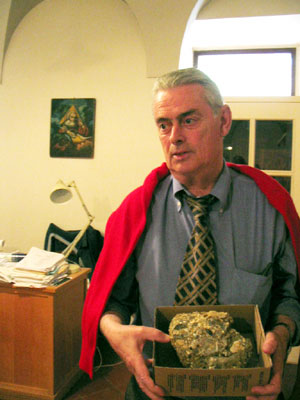 |
|
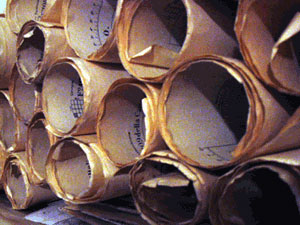
|
Upon
graduation, Romanini formed a geology partnership with a friend,
but the business soon failed. Out of a job, he heard about
an opening for a teaching position in math and science in
Cantiano, about 20 minutes from Cagli. In 1964, he also taught
in S. Sepolcro, Tuscany, as well as Cagli, but simultaneously
continued his graduate studies in geology. In the early 1980s,
Romanini opened his own private Studio di Geologia, adjacent
to his home in Cagli.
From 1985 to 1994, Romanini served on the National Council
of Geologists. In his third term, he was elected vice president.
|
|
In
1991, Romanini retired from teaching and has concentrated
primarily on his consulting business, accepting contracts
that called him to apply his knowledge of geology to engineering.
He works with construction planners, who ask him to analyze
the rock formations of the area and determine whether the
land is stable enough for building projects. Other typical
projects of his include hydrological research, foundation
studies, quarry planning, and landslide renovation.
When
a landslide covered Leontina Road in Tausano mountain on Oct.
18, 1969, in an area between San Marino and San Leo, Romanini
applied his knowledge of the local geology to engineering
and solved the problem.
Romanini was working in a private studio in Pesaro. The province
of Pesaro had discovered the problem and asked him to join
in the solution.
|
|
The
land surrounding Leontina road had been saturated with water,
and had begun to seep out. Over time, the excess water formed
a small body similar to a lake. The surplus water pressed
on the land, causing a landslide that fell over Leontina Road,
pulling part of it into the Torrente Mazzocco River.
Because Leontina Road is as an important transportation route,
the province of Pesaro reacted immediately. Romanini and a
colleague analyzed the land from the landslide and concluded
that the rock contained too much water. Together, they devised
a plan to drain all the water and stop the landslide.
|
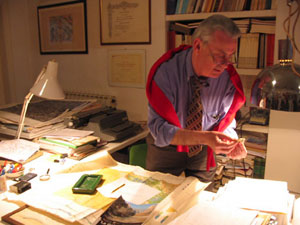 |
|
In the interim
an off-road detour was opened. After two years, the landslide
was stopped.
Romanini deems the experience, “my most important accomplishment
because I helped devise a plan to fix a problem.” Fixing
the landslide is an example of the way Romanini uses his education
in geology as a consultant to solve regional engineering problems.
This project, one of the first in Italy applying geology to
engineering, made Romanini a pioneer in his field.
“Man could always
adapt to its environment but the ammonites couldn’t;
they became extinct and exist now as fossils of the
land that once was.” |
When
presented with a problem, Romanini consults area geological
maps. However, it takes more than maps to solve the problem.
“Geologic maps contain such small scales and these tools
alone are not enough to do the job. Like an explorer of Africa,
you begin with a map. But you must also go there to see exactly
what you are going to find. Only when you can venture and
study the structures, when you can touch, feel, and even smell
them, can you begin to analyze them,” he said.
|
 |
In
a lab connected to his Studio di Geologia, Romanini analyzes
rock samples. First, he weighs them in their natural form
and dries the samples in an oven at 110∞ C from about
four to seven hours. Then he weighs the dry samples and records
their weight and water percentage, and tests their texture
and particle composition. He looks for clues such as color,
size of crystals, fossil formations, and the like. Finally,
he draws his conclusions and proposes solutions.
“If you know the different animals that existed in various
time periods, you can tell the age of the rock by looking
at the fossils within it,” said Romanini.
|
|
“Man could always adapt to its environment but the ammonites
(a 200 million-year-old species located in Gola del Burano),
couldn’t; they became extinct and exist now as fossils
of the land that once was.”
Romanini said Cagli contains the widest variety
of rock categories in Italy, with the oldest ones about 200
million years old, mostly located in the region of Gola del
Furlo, Gola del Burano, and in the Gola del Bosso.
|
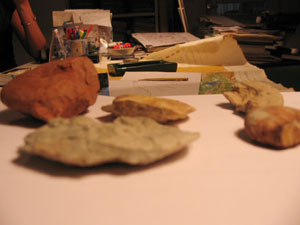
|
|
“Everything in Cagli has already been
discovered. I observe the types of rocks which exist here
and work on jobs elsewhere when I am called. There have only
been a few specific problems I have attended to in Cagli.
One example is the study I participated in on Mount Petrano.
It was a search for water in order to rebuild the national
television tower because it fell.”
|
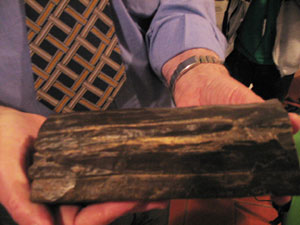 |
Millions of years ago, Mount
Petrano was one large mountain, but now exists as an example
of a geologic phenomenon of river and weather erosion.
Over time, the natural course of the river
dug into the weakest spot in the rock, gradually eroding the
bottom of the mountain.
Simultaneously, rain and wind
pushed down on top of the mountain, causing similar erosion.
Eventually, both the river and weather pushed hard enough
to form two new separate mountains. |
|
“If you look close enough, you will
notice that the two pieces appear to fit together like a puzzle,”
he said. “That’s how you know the truth of their
history.” |
|
|

